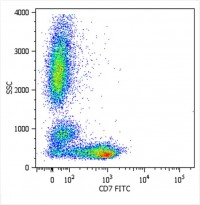ARG62919
anti-CD7 antibody [MEM-186] (FITC)
anti-CD7 antibody [MEM-186] (FITC) for Flow cytometry and Human
Immune System antibody
Overview
| Product Description | FITC-conjugated Mouse Monoclonal antibody [MEM-186] recognizes CD7 |
|---|---|
| Tested Reactivity | Hu |
| Tested Application | FACS |
| Specificity | The clone MEM-186 reacts with CD7, a 40 kD type I transmembrane glycoprotein expressed on peripheral blood T lymphocytes, NK-cells, hematopoietic progenitors, monocytes (weakly) and also on acute lymphocytic leukemia. HLDA VI; WS Code T 6T-015 |
| Host | Mouse |
| Clonality | Monoclonal |
| Clone | MEM-186 |
| Isotype | IgG1 |
| Target Name | CD7 |
| Antigen Species | Human |
| Immunogen | Human acute myelogenous leukaemia cell line KG-1. |
| Conjugation | FITC |
| Alternate Names | TP41; Tp40; T-cell antigen CD7; CD antigen CD7; T-cell leukemia antigen; LEU-9; T-cell surface antigen Leu-9; GP40 |
Application Instructions
| Application Suggestion |
|
||||
|---|---|---|---|---|---|
| Application Note | * The dilutions indicate recommended starting dilutions and the optimal dilutions or concentrations should be determined by the scientist. |
Properties
| Form | Liquid |
|---|---|
| Purification Note | The purified antibody is conjugated with Fluorescein isothiocyanate (FITC) under optimum conditions. The reagent is free of unconjugated FITC and adjusted for direct use. No reconstitution is necessary. |
| Buffer | PBS, 15 mM Sodium azide and 0.2% (w/v) high-grade protease free BSA |
| Preservative | 15 mM Sodium azide |
| Stabilizer | 0.2% (w/v) high-grade protease free BSA |
| Storage Instruction | Aliquot and store in the dark at 2-8°C. Keep protected from prolonged exposure to light. Avoid repeated freeze/thaw cycles. Suggest spin the vial prior to opening. The antibody solution should be gently mixed before use. |
| Note | For laboratory research only, not for drug, diagnostic or other use. |
Bioinformation
| Database Links | |
|---|---|
| Gene Symbol | CD7 |
| Gene Full Name | CD7 molecule |
| Background | CD7, also known as gp40, is a member of the immunoglobulin superfamily found on T cells, NK cells, thymocytes, hematopoietic progenitors, and monocytes (weakly). CD7 is also expressed on acute lymphocytic leukemia (ALL). CD7 crosslinking induces a calcium flux in T lymphocytes, presumably as a result of cytoplasmic domain association with PI3-kinase. CD7 co-stimulation can induce cytokine secretion and modulate cellular adhesion. A ligand of CD7, epithelial cell secreted protein K12, is produced in thymus to regulate thymocyte signaling and cytokine release. In lung microvascular endothelial cells CD7 serves as an IgM Fc receptor. Expression of CD7 is an important marker used in leukemia diagnostics. |
| Function | Not yet known. [UniProt] |
| Research Area | Immune System antibody |
| Calculated MW | 25 kDa |
Images (1) Click the Picture to Zoom In






